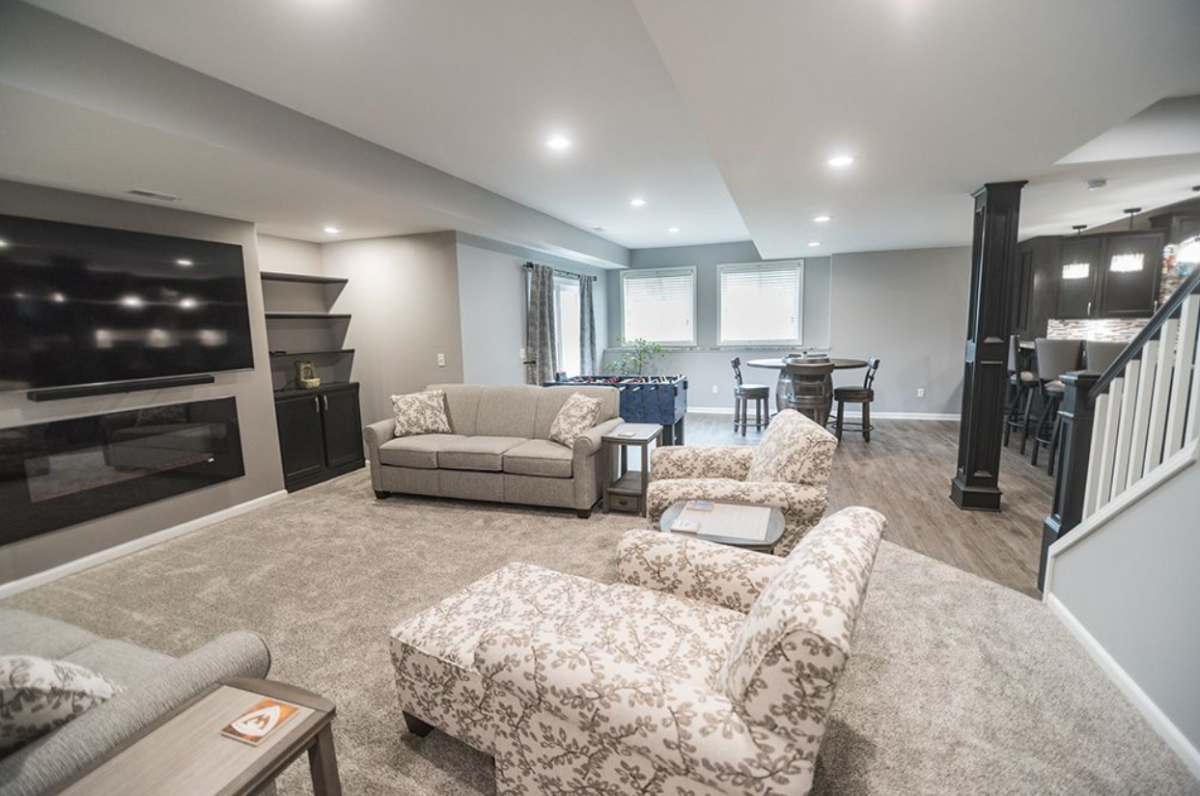A basement serves as the foundation of a home, both literally and figuratively.
Sterling Heights, United States - October 23, 2023 / Everdry Waterproofing of S.E. Michigan /
Basement Repair Methods: Preventing Structural Issues
A basement serves as the foundation of a home, both literally and figuratively. It provides essential support and utility, making it vital to maintain its structural integrity. Over time, various factors can lead to wear and tear, requiring homeowners to implement basement repair methods to ensure their property’s longevity and safety. In this article, we’ll delve into some common basement repair methods used to address a range of structural issues.
1. Crack Injection: Restoring Structural Integrity
Cracks in the walls and floors of a basement are a common concern for homeowners. These cracks can develop due to various factors such as settling of the foundation, shifts in the surrounding soil, or the pressure exerted by groundwater, known as hydrostatic pressure. Not only are these cracks unsightly, but they can also lead to serious structural issues and water infiltration. Fortunately, crack injection is a highly effective and cost- method for addressing these problems.
The Process:
Crack injection is a precise and efficient repair method. It involves injecting either epoxy or polyurethane resin into the concrete floor into the cracks. Here’s a closer look at how this process works:
- Assessment: The first step in the crack injection process is to assess the size and nature of the cracks. Small, non-structural cracks can often be sealed with a basic sealant, but for larger or structural cracks, epoxy or polyurethane injection is necessary.
- Surface Preparation: To ensure a strong bond, the technician will typically clean the crack, removing any loose debris or contaminants. This step is crucial as it guarantees that the injected material adheres securely to the crack’s surfaces.
- Injection: Epoxy or polyurethane resin is mixed and prepared for injection. The choice between epoxy and polyurethane often depends on the nature of the crack and the specific requirements of the repair. Epoxy is known for its incredible strength and is ideal for structural repairs, while polyurethane provides flexibility and is excellent for sealing non-structural cracks.
- Injection of Resin: The selected resin is injected directly into the crack, filling the entire void. This not only seals the crack but also reinforces the surrounding structure.
- Curing: As the resin cures, it hardens and forms a strong, waterproof seal. The curing time may vary depending on the type of resin used but typically ranges from a few hours to a day. Once cured, the resin is as strong as or even stronger than the surrounding concrete.
Benefits of Crack Injection:
- Restored Structural Integrity: One of the primary benefits of crack injection is that it effectively restores the structural integrity of the wall or floor. This is especially crucial for structural cracks that could compromise the safety and stability of your home.
- Waterproofing: The injected resin forms a waterproof seal, preventing water from seeping through the cracks. This is vital for keeping your basement dry and avoiding water-related issues like mold growth and foundation damage.
- Cost-Effective: Crack injection is a cost-effective method compared to extensive structural repairs or foundation replacement. It offers a long-lasting solution that doesn’t break the bank.
- Minimally Invasive: Unlike some other repair methods that require major excavation and disruption to your basement, crack injection is minimally invasive. It can often be completed within a day, minimizing the inconvenience to homeowners.
2. Interior Drainage Systems: Managing Moisture
Moisture is a common nemesis in basements. It can lead to a range of issues, from musty odors and mold growth to structural damage. Interior drainage systems are a vital component of waterproofing your basement and moisture management, offering an effective solution to prevent water infiltration and keep your basement dry.
How Interior Drainage Systems Work:
Interior drainage systems, such as French drains and channel drains, are designed to collect and divert water away from the surface of your basement’s interior, preventing it from seeping into the foundation. Here’s how these systems work:
- Subfloor Drainage: These systems are installed beneath the basement floor, typically around the perimeter of the space. They consist of a network of pipes or channels that capture any water that penetrates the foundation or accumulates on the basement floor.
- Collection of Water: When moisture enters your basement through wall cracks, foundation leaks, or other entry points, the interior drainage system intercepts it. The water is channeled into the subfloor drainage system, preventing it from pooling on the basement floor.
- Diversion of Water: Once the water is collected by the drainage system, it is channeled to a sump pit or a designated drainage outlet. From there, it is efficiently pumped out of the basement by a sump pump. The sump pump is responsible for expelling the collected water safely away from your home.
Benefits of Interior Drainage Systems:
- Effective Moisture Management: Interior drainage systems are highly effective at managing moisture in basements. By collecting and diverting water away, they prevent water infiltration and the associated problems, such as mold growth and structural damage.
- Reduced Humidity: Moisture in the basement can lead to increased humidity levels throughout your home, potentially affecting indoor air quality and causing discomfort. Interior drainage systems help maintain a drier, more comfortable living environment.
- Prevent Mold and Mildew: By keeping the basement dry, these systems are a proactive measure against mold and mildew growth, which can be harmful to both your property and your health.
- Protection Against Flooding: While not designed to handle severe flooding like a sump pump, interior drainage systems can provide an additional layer of protection against minor water intrusion or seepage.
- Long-Term Solution: Once installed, interior drainage systems offer a long-term solution to moisture issues in your basement. They require minimal maintenance and can effectively protect your property for years to come.
When to Consider Interior Drainage Systems:
Consider installing an interior drainage system if you:
- Experience water seepage or moisture issues in your basement.
- Notice musty odors or see signs of mold and mildew.
- Live in an area prone to heavy rainfall, high water tables, or hydrostatic pressure issues.
- Want to protect your basement from potential damage and maintain its structural integrity?
3. Sump Pump Installation: Preventing Flooding
A sump pump is a critical component in the battle against basement flooding. It acts as the last line of defense, ensuring that excess water doesn’t compromise the integrity of your home or create a potentially hazardous environment. Sump pump installation is a proactive measure to prevent basement flooding, so installing and understanding its importance is key to maintaining a dry and safe living space.
How Sump Pumps Work:
Sump pumps are typically installed in a designated pit or sump pit in the lowest part of the house or basement, commonly located on the basement floor. Here’s how they function:
- Water Collection: Excess water from various sources, such as heavy rain, rising groundwater, or foundation seepage, naturally flows into the sump pit due to gravity.
- Activation: The sump pump is equipped with a float switch or other sensor that detects the rising water level in the sump pit. When the water reaches a certain point, the pump is automatically activated.
- Pumping Action: The sump pump’s impeller then pumps the collected water out of the sump pit and through a discharge pipe, which directs the water away from your home’s foundation and into a safe drainage area, such as a storm sewer or a dry well.
- Deactivation: Once the water level in the sump pitfalls below the designated level, the sump pump deactivates. It remains on standby until the next flooding event.
Benefits of Sump Pump Installation:
- Preventing Flooding: The primary purpose of a sump pump is to prevent basement flooding. By efficiently removing excess water as it enters the sump pit, a sump pump helps keep your basement dry even during heavy rainfall or water table fluctuations.
- Protecting Property: Flooded basements can lead to extensive damage to your property, including ruined possessions, structural damage, and mold growth. Sump pumps act as an insurance policy against these costly issues.
- Maintaining Indoor Air Quality: A dry basement is essential for good indoor air quality. Preventing flooding with a sump pump reduces the risk of mold and mildew growth, which can affect the air you breathe.
- Minimizing Health Risks: Flooded basements can create health hazards, particularly when they lead to mold or pest infestations. Sump pumps help maintain a safe and healthy living environment.
- Preserving Home Value: Regular sump pump maintenance and functionality can enhance your home’s resale value. Potential buyers are often attracted to properties with reliable flood prevention measures in place.
Choosing the Right Sump Pump:
When considering sump pump installation, it’s essential to choose the right type of sump pump for your specific needs. There are two primary types:
- Submersible Sump Pumps: These pumps are installed inside the sump pit. They are quieter and more discreet but generally have a shorter lifespan.
- Pedestal Sump Pumps: Pedestal pumps are installed above the sump pit. They are more accessible for maintenance and typically have a longer lifespan. However, they are noisier than submersible pumps.
4. Wall Anchors and Bracing: Stabilizing Leaning Walls
Leaning or bowing basement walls are a cause for concern, as they indicate structural issues that can compromise the safety and stability of your home. Wall anchors and bracing are effective methods for stabilizing and reinforcing these basement walls, preventing further movement and ensuring the integrity of your basement.
The Need for Wall Stabilization:
Leaning or bowing basement walls often result from the pressure exerted by water damaging the soil surrounding the foundation. Several factors can contribute to this problem, including:
- Hydrostatic Pressure: Groundwater in the soil can exert significant hydrostatic pressure on basement walls, pushing them inward.
- Expansive Soil: Some soils expand and contract with changes in moisture content, causing lateral pressure on the walls.
- Poor Drainage: Inadequate drainage around the foundation can exacerbate hydrostatic pressure, leading to wall movement.
- Tree Roots: The growth of nearby trees can disrupt the soil, causing uneven pressure against the foundation.
Wall Anchors and Bracing:
Wall anchors and bracing are two methods commonly used to address leaning or bowing basement walls. They work by counteracting the forces that are pushing the concrete walls inward and providing structural support to prevent further movement.
Wall Anchors:
- Installation: Wall anchors involve installing anchors deep into the ground outside the foundation wall and attaching them to a plate inside the basement wall. The anchor’s design allows it to be tightened over time, gradually straightening and stabilizing the wall.
- Effectiveness: Wall anchors are highly effective at addressing moderate to severe wall bowing and are a long-term solution. They can often restore the wall to its original position or close to it.
- Minimal Disruption: Wall anchor installation is relatively non-invasive and minimizes disruption to the landscaping and interior of your home.
Wall Bracing:
- Installation: Wall bracing, also known as I-beams or wall reinforcement systems, involves attaching steel supports to the interior of the wall, providing immediate stabilization. These braces resist inward pressure and maintain wall integrity.
- Effectiveness: Wall bracing is suitable for addressing less severe bowing or leaning walls. It provides both structural support and an immediate solution to prevent further movement.
- Versatility: Wall bracing systems are versatile and can be installed in basements with limited space or those with finished interiors.
Benefits of Wall Anchors and Bracing:
- Structural Integrity: The primary benefit is the restoration and maintenance of the structural integrity of your basement walls. This prevents the risk of collapse and other structural damage.
- Preventing Further Movement: Wall anchors and bracing systems effectively counteract the forces causing the walls to bow or lean, preventing further inward movement.
- Cost-Effective: When compared to more extensive foundation repair or wall replacement, wall anchors and bracing are cost-effective solutions.
- Minimal Disruption: The installation of wall anchors or bracing is relatively non-invasive, causing minimal disruption to your property.
- Versatility: These methods are adaptable to different types of basement walls, and they can be customized to suit the severity of the issue.
Ensuring a Secure and Comfortable Living Environment
Maintaining a structurally sound and dry basement is essential for the overall well-being of a home. By understanding common basement repair methods, homeowners can take proactive steps to address various issues that may arise over time. From crack injection and interior drainage systems to sump pump installation and exterior and waterproofing products, these methods offer effective solutions for different structural challenges. Consulting with professionals and conducting regular maintenance can help homeowners ensure the longevity and safety of their basements, creating a more secure and comfortable living environment.

Contact Information:
Everdry Waterproofing of S.E. Michigan
33533 Mound Rd
Sterling Heights, MI 48310
United States
Jeff Schleuning
(586) 698-3030
https://everdrymichigan.com
Original Source: https://everdrymichigan.com/media-room/




